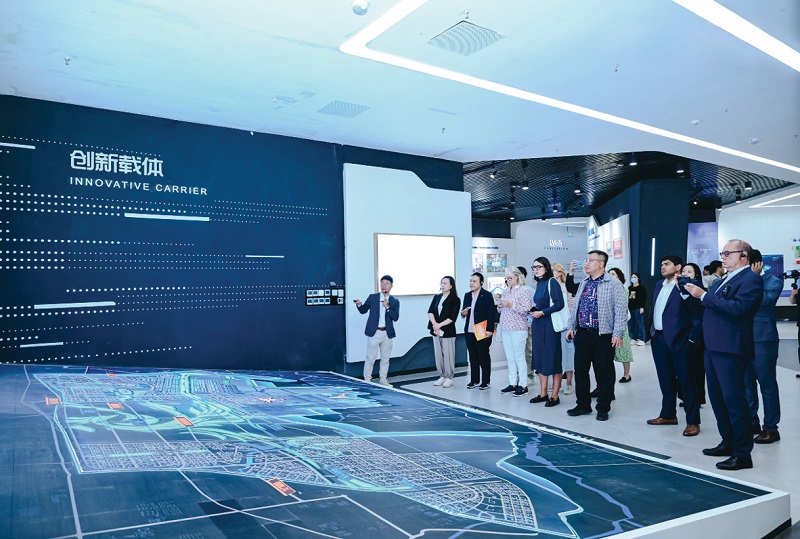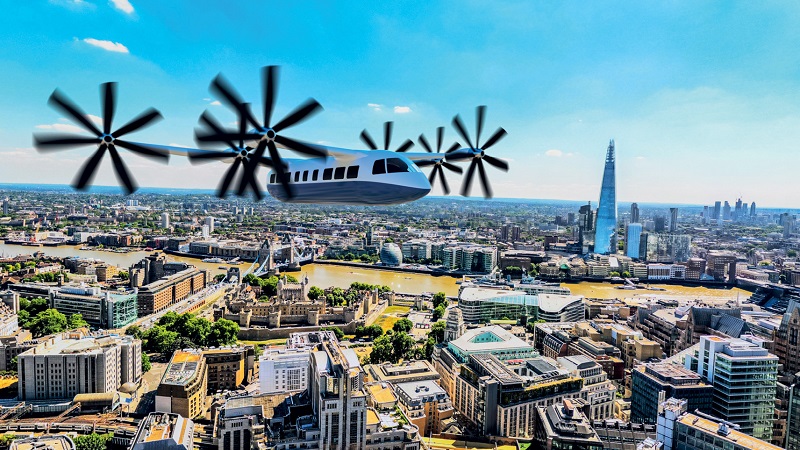A U.K.-based startup is eyeing the Chinese market for its 30-seater aircraft that its CEO says will make air services accessible to the general public.

Furqan (right, second), CEO of Sora, visits the Beijing Daxing International Airport on September 27, 2024.
Sora Aviation is a U.K.-based startup developing a “sky bus” or S-1, an electric vehicle with 30 seats capable of taking off and landing vertically (eVTOL). Furqan, CEO of Sora, thinks that while air taxis will serve the premium market, eVTOL buses like his will make air mobility affordable for the general public.
His sights are set on the huge Chinese market, especially in view of the development of China’s low-altitude economy in recent years. In this exclusive interview, he tells China Today why the S-1 will be the people’s transport in future and what is making China a leader in aerial mobility.

Furqan, CEO of Sora Aviation.
China Today: Why did you want to develop a 30-seat eVTOL bus? What’s its market potential?
Furqan: The most effective way to reduce per-passenger costs in advanced air mobility (AAM) is by increasing capacity. By carrying more passengers, the operational costs of each trip are spread across a larger number of seats, enabling lower ticket prices. We estimate that the cost per passenger on a 30-seat piloted eVTOL bus will be about a quarter of that on a four-seat piloted air taxi.
The largest market segment for AAM is likely to be airport shuttles, where demand is extremely high. It simply makes more sense to use a 30-seat eVTOL for these routes — it’s more affordable for passengers and more scalable for operators, requiring fewer aircraft, pilots, and flights to move the same number of people.
China Today: Where can the S-1 be used?
Furqan: The S-1 is specifically designed for short-distance missions under 160 kilometers, where runway independence is essential. We’re exploring urban use cases like connecting airports to city centers, major districts, and suburbs, as well as commuter routes linking residential areas to central business districts. Another key use focuses on overcoming challenging geography, such as island-hopping or crossing fjords. In all of these scenarios, the S-1 is designed with affordability in mind, making air mobility accessible to the average person — not just business executives or high-net-worth individuals.
China Today: When will the S-1 be put on the market?
Furqan: We’re currently in the preliminary design phase. Apart from designing and testing the aircraft, we’re engaging airlines, airports, vertiport developers and regulators to ensure that the operational procedures, infrastructure, and regulations are in place to accommodate the S-1. We’ll be raising our Series A round (of fundraising) soon to fund the next stages of the S-1’s development. Our goal is to achieve the first flight by 2028, and entry into service by 2031. While that may seem far off, in the aerospace industry, it’s actually a fast-paced development timeline.
China Today: How do you see the development of China’s low-altitude economy?
Furqan: China has established a stronghold in the commercial drone market, particularly in Shenzhen (in the south), where companies like DJI hold a significant share globally. The Civil Aviation Administration of China is now opening up low-altitude airspace to facilitate air taxi trials in cities such as Guangzhou and Shanghai. By prioritizing technology, infrastructure, and regulatory reform, China is positioning itself as a leader in aerial mobility and the low-altitude economy.

A designer’s rendering of what the Sora S-1 eVTOL bus cruising over London would look like. Photo courtesy of Furqan
 China Today: Which particular regions or cities in China do you see as having the most promising opportunities for developing the low-altitude economy?
China Today: Which particular regions or cities in China do you see as having the most promising opportunities for developing the low-altitude economy?Furqan: During my recent visit to the Daxing International Airport in Beijing, it quickly became clear that megacities like Beijing and Shanghai present immense market potential due to their dense populations and congestion. However, with over a third of China’s population still residing in rural areas, there are equally significant opportunities to enhance connectivity through cargo drone deliveries and passenger eVTOL services.
China Today: Are there any unique advantages that China offers in the industry compared to the U.K. or other markets in which your company operates?
Furqan: I think each country has its advantages and challenges. The U.K., for example, has a long history of aircraft design and manufacturing, which is a key industrial strength for the country. On the other hand, China adopts a rapid pace of infrastructure development which is critical to ensure vertiport development doesn’t significantly lag behind aircraft development. China’s speed, investment, and market size create exciting opportunities for growth in aerial mobility.
China Today: Does Sora have any collaboration with Chinese companies?
Furqan: China’s massive market potential, combined with lower average disposable incomes, makes a low-cost, high-capacity vehicle like the S-1 more appealing than air taxis. The large population in Chinese cities also favor larger eVTOLs, making it easier to scale this new mode of transport efficiently. We’re excited about potential collaboration with Chinese airlines, airports, and cities to explore the deployment of the S-1 in China. Our goal is to ultimately provide an affordable and accessible air mobility service for the Chinese public.
China Today: In your opinion, in which specific areas can China and the U.K. cooperate to promote the development of the eVTOL bus industry? How can they cooperate?
Furqan: The key area is harmonizing regulations for the Type Certification and operation of eVTOL aircraft. The U.K., for example, has adopted the European Union Aviation Safety Agency’s standards to ensure the highest levels of safety in AAM. Aligning on energy reserve requirements, pilot licensing, and other operational regulations across regions would greatly benefit the industry, facilitating global deployment and accelerating the adoption of eVTOLs.